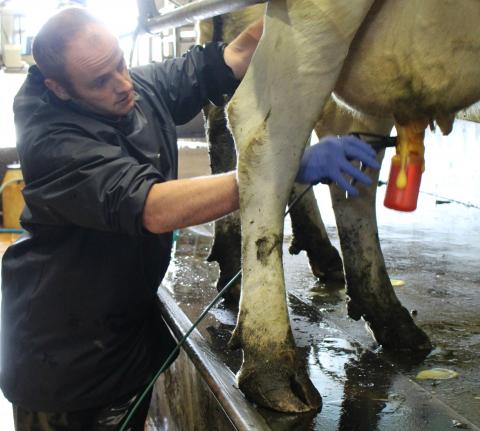Reducing the use of antibiotics at drying off is resulting in significant savings at a Farming Connect dairy Demonstration Farm.
By implementing Selective Dry Cow Therapy (SDCT) at Tyreglwys, Llangennech, farmer Geraint Thomas has reduced costs by £7.40 per cow across 80% of his herd. As well as cost savings, SDCT also encourages responsible use of medicines by reducing antibiotic use, which is important in light of resistance issues. Blanket dry cow therapy involves using antibiotics on all cows at drying off, with UK herds spending an average of £7531 on antibiotics in 2014 and every cow receiving three treatments of antibiotics in one lactation.
There is a belief that using antibiotics at drying off will clear any existing infection and prevent any new infection during the dry period. However, this is not the case, as vet Sarah-Jane Redman told farmers at an open day at Tyreglwys: “People think they’re protecting their cows with antibiotics, but that treatment doesn’t persists, so at calving she’s not protected. We want to save our antibiotics for when we do have an issue, not when we don’t. It doesn’t make sense to treat an animal with a somatic cell count of 50 with antibiotics because there’s absolutely no infection in that udder.
“Also, everything has a colony of bacteria, but if we’re putting antibiotics in there, we’re killing the cow’s own flora, so that cow then is very vulnerable to new infection.”
SDCT can reduce the prevalence and severity of coliform (e-coli) mastitis by up to six times in the next lactation, which could represent a significant saving, at an average of £450 per case in terms of milk loss and antibiotic use.
Instead of treating all cows with antibiotics at drying off, Geraint only uses teat sealant on cows which have had a Somatic Cell Count (SCC) of 200 or lower at milk recording for the last three months of lactation. These readings show that there is no infection present and therefore no need for antibiotics. SDCT has to be performed on the whole udder as infection can cross between quarters. Animals with teat abnormalities may not be suitable for SDCT and yield at drying off is also very important.
A study conducted by Bradley and Green in 1998 showed that every 1 litre increase in yield at drying off produces a 6% increase in risk of a new dry period infection.
Another important factor to consider before implementing SDCT in the herd is your bulk milk tank somatic cell count, as there must be enough margin for it to increase slightly because SDCT positively encourages the development of natural flora in the cow’s udder to improve immunity.
“We’re trying to increase our SCC for the health of the cow. Cows who were maybe 50 before could potentially creep up to 52-54, so there has to be room to allow that bulk tank SCC to creep up slightly,” added Sarah-Jane.
All farms should consider doing SDCT but should chose threshold according to bulk milk tank SCC. Before preparing a SDCT plan farmers should seek advice from their vet to ensure an effective treatment.
Geraint and vet Stephen Davies then gave a demonstration of the strict protocols that must be followed when drying off cows to prevent trapping bacteria in the udder with teat sealant.
“Drying off has to be done as a separate job, not during the milking routine because hygiene needs to be absolutely meticulous. It has to be in a clean parlour after milking or before,” said Stephen.

